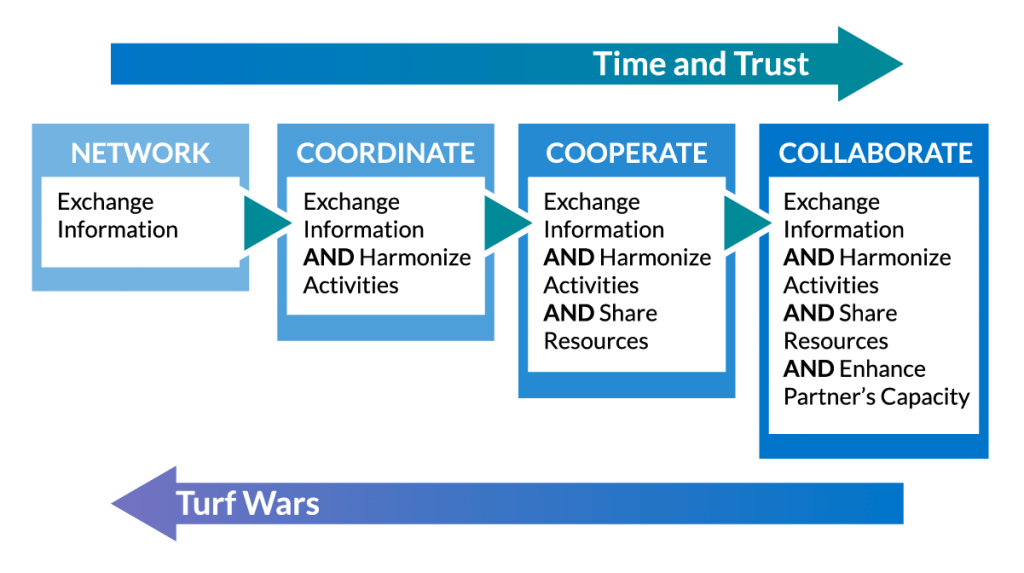
| Module 1 | Background |
Unit 1
|
Unit 2
| |||||
|---|---|---|---|---|---|---|---|---|
| Module 2 | Partnerships |
Unit 1
|
Unit 2
|
Unit 3
| ||||
| Module 3 | Proposed indicators |
Unit 1
| ||||||
| Module 4 | School attendance |
Unit 1
|
Unit 2
|
Unit 3
|
Unit 4
| |||
| Module 5 | School disciplinary actions |
Unit 1
|
Unit 2
|
Unit 3
| ||||
| Module 6 | School readiness |
Unit 1
|
Unit 2
|
Unit 3
| ||||
| Module 7 | Next steps |
Unit 1
| ||||||
| Module 8 | Appendices |
Unit 1
|
Unit 2
|
Unit 3
|
Unit 4
|
Unit 5
|
Unit 6
|
Unit 7
|
| Module 9 | References |
Unit 1
|

 What is the role of partnerships in information sharing?
What is the role of partnerships in information sharing?
Rarely is one organization or agency solely responsible for the collection of all CAMH data. For example, CAMH data could be collected by schools, hospitals, or juvenile justice agencies, to name just a few. Building and maintaining effective partnerships across both governmental and non-governmental partners enhances the ability to assess, monitor, and improve CAMH. Effective partnerships can lead to increased knowledge, coordinated funding and improved trust.
- Given how scattered CAMH data are across sectors, pooling data from disparate partners and sources could provide a more complete picture of CAMH. Each partner brings their own perspective and expertise on CAMH, yielding a deeper understanding of the challenges, solutions, and possible interventions that can lead to improved understanding of the data.
- A combination of data sharing and use agreements, memoranda of understanding (MOU), or other mechanisms to clarify the proposed purpose and use of data are usually created at the start of the partnership to lay the groundwork for the future. PHII’s Information Governance for Public Health provides guidance that could be incorporated into such partnership agreements.
- Working with partners can enhance understanding and use of the proposed data and indicators to assess and improve CAMH. Working with organizations that collect or maintain these data can help all partners to understand the strengths and limitations of the data. The data can reveal answers about prevalence, underlying causes, or areas of interest. The data and indicators can also help identify specific populations or subpopulations that might need additional support. The National Association of State Boards of Education’s How Schools Work & How to Work with Schools provides guidance and tips for effectively working with schools.
Federal funding
Schools and school districts are important partners in the effort to promote CAMH. The CDC’s Division of Adolescent and School Health (DASH) developed “Promoting Mental Health and Well-Being in Schools: An Action Guide for School and District Leaders.”2 The action guide helps school and district leaders build on what they are already doing to promote students’ mental health. It describes six in-school strategies that are proven to promote and support mental health and well-being. For each strategy, the guide also describes approaches, or specific ways to put the strategy into action, and examples of evidence-based policies, programs and practices.
![]()
- Partnerships can be leveraged to enhance funding by using a layered approach.
- Building information partnerships can help leverage, layer, pool, and diversify funds for CAMH from multiple sources. Such partnerships might not be easy to create, but most funders—governmental or philanthropic—value collaborative partnerships and appreciate evidence of established partnerships. As a result, working with partners can appeal to funders and even open doors to funding opportunities that public health alone would not receive.
![]()
- The image below illustrates the value of spending time with partners through the stages of networking, coordination, cooperation, and collaboration to build or enhance trust.3 As partners move from one stage to the next, the level of trust among partners and the benefits of the partnership increase.
Federal funding
Federal organizations that provide funding for mental health activities and research include the Centers for Disease Control and Prevention (CDC), National Institutes of Health (NIH), National Institute of Mental Health (NIMH), Substance Abuse and Mental Health Services Administration (SAMHSA), Health Resources and Services Administration (HRSA) and the Centers for Medicare and Medicaid Services (CMS).
Health departments can benefit from identifying and reaching out to form partnerships with other agencies that are funded by these types of organizations. Additional information about organizations that provide mental health funding specifically for research can be found here.
- Regular and honest communication is important for improved trust. Communicating the benefit each partner will receive and their role in assessing and improving CAMH will help to create a valuable partnership. More information will be provided on how to determine the benefit and role of each partner in the section below. Tip<i>Effective communication is key to building and maintaining productive partnerships, and listening is key to effective communications. All partners can benefit from honing their listening skills, which allow us to not only hear but also pay attention to the messages and stories of others. These messages and stories often include valuable information and might even provide insight into solutions for common challenges. </i>




